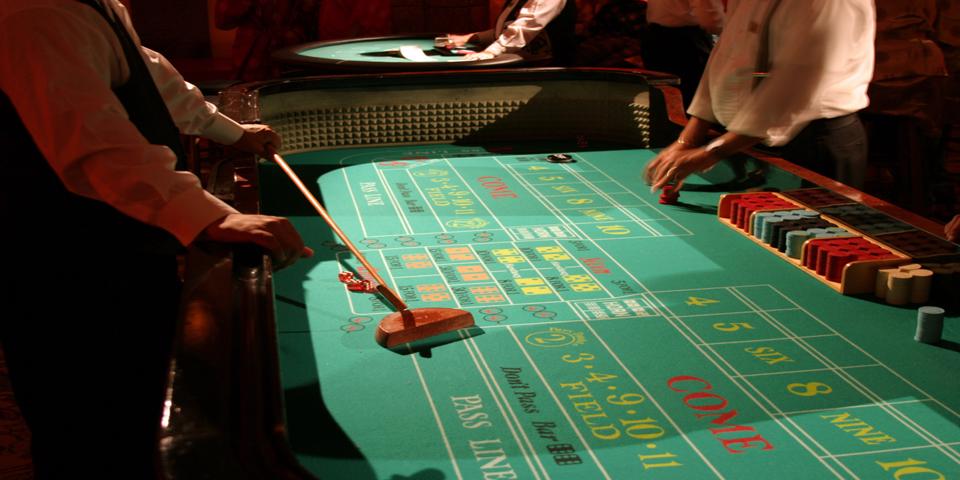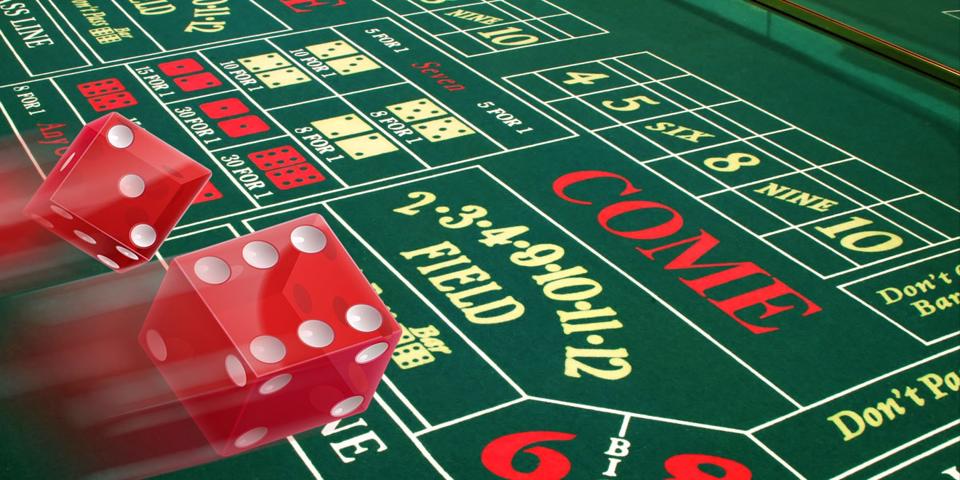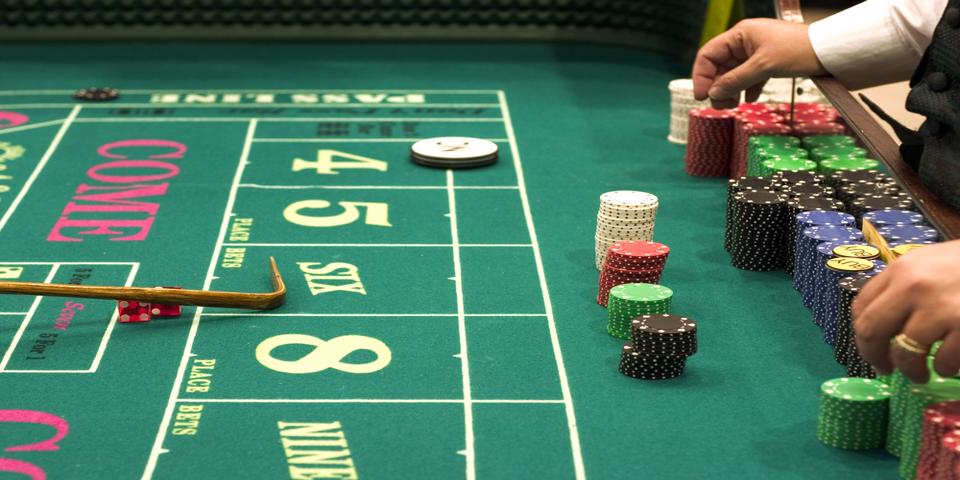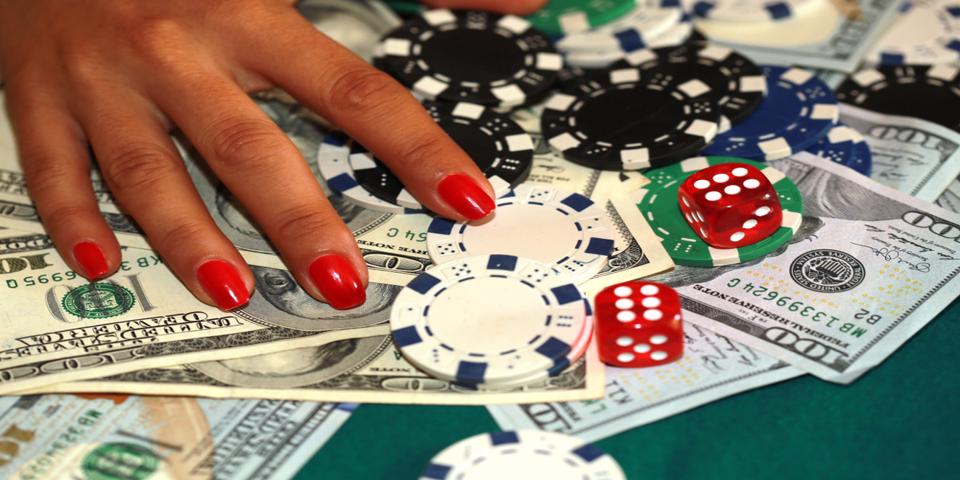Craps Rules: A Quick Step-by-Step Guide

‘Craps’ refers to the casino game played with a pair of dice in which a 7 or 11 is a winning throw and a 2, 3 or 12 is a losing throw in the fundamental bet. If a player (the “shooter”) throws anything else, the throw must be repeated.
Craps: the Basics
If you’re in the casino with a view to enjoying its party scene, chances are that it’s craps you’ll choose to spend your time playing, over poker, slots, or blackjack.
Walk into any North American casino and you’ll easily identify the craps tables from the loud cheering, buzzing atmosphere and clattering of dice as they hit and bounce around the purpose-built table.
This game is one that can accommodate up to 20 players at any one time and kicks off with a player–referred to as the shooter–rolling (or shooting) the dice down the table. Shooters will typically alternate following the end of a round although it’s not uncommon for one player to remain in position for a number of rounds at a time.
Although only one player can shoot the dice at any time, anyone can wager on the outcome of the dice by placing chips in the appropriate zones on the felt. The betting layout can be confusing at first, as can the outcomes of the dice, but don’t worry–we’ll get into the details in just a second!
Craps Table Employees

When it comes to the staff required for craps, it’s one of the more employee-heavy games in any casino, with three separate roles required to keep an eye on the gameplay.
The ‘Boxman’
First up, we’ve got the boxman, who’s the employee responsible for all of the chips at the table.
The boxman will exchange cash into chips, swap out different chip denominations and hold the responsibility of supervising the dealers, ensuring that the game as a whole is running smoothly, without any sort of hitch to spoil the play. This is especially vital with such a high-energy atmosphere around a table.
The ‘Stickman’
Next up, it’s the stickman–no, not the badly drawn ones you used to doodle in kindergarten. The stickman is the employee with a stick, of course. This individual looks after the dice when playing craps.
The stickman uses a stick (hence the name) to control the dice in play at the table, pushing the dice and passing them down to the shooter at the start of each of the rolls. It’s also the stickman’s job to announce the outcome of each of the rolls, making theirs the most important voice at the table. And to be heard over all the noisy melee surrounding craps, this voice needs to be a loud one!
The ‘Base Dealers’
Last up, we’ve got the base dealers and although given a single name, it’s a role always assigned to two employees standing either side of the table.
It’s the base dealers’ job to collect losing bets and pay out the winners, so they’re the employees in charge of your pennies. When requested to do so, the base dealers are also able to place certain bets on behalf of the players around the table, another vital role in the game of craps.
You can now see how, with three to four employees surrounding the table at any one time, craps constitutes the most employee-heavy game at the majority of Las Vegas–and other–casinos. But, with up to 20 players at a time also surrounding the dice, it’s hardly a surprise.
Craps: How to Play
Craps can be one of the most confusing games for newcomers to pick up, thanks to a confusing betting layout and the sheer number of different wagers able to be made when playing.
However, that shouldn’t put players off when they’re interested in the game, since knowledge will soon accrue and it’s actually not that complex. It won’t take long to pick up the gameplay and become a craps expert–even within a single gaming session.
So, let’s work from the start and figure out exactly how to play craps.
Let’s Kick Things off at Craps

Craps will always start in the same way, with the shooter (the player in charge of throwing the dice) being presented with a number of dice, usually five, by the stickman. From these five dice, the shooter must choose two to roll.
Following this, the remaining dice are returned to the stickman’s bowl and the shooter must wager at least the table minimum on either the Pass Line or the Don’t Pass Line, both found on the felt.
The shooter is required to handle the dice with a single hand and, upon throwing, the dice must hit and bounce off the opposite end of the purpose-built table. If one or both of the ricocheting dice leave the table and visit the ground, they are to be inspected by the stickman who determines whether or not they are fit for further play. In fact, the condition of the dice is extremely important to the successful game of craps, most being swapped out for new dice within just a few games.
Note: the Pass Line can be referred to as the “win” or “right” bet, whereas the Don’t Pass Line can conversely be known as the “lose” or “left” bet.
The Round System
Craps is a round-based game, in that it’s played in rounds where the shooter is determined by shifting one player clockwise following the end of each round.
A player who doesn’t want to roll is not required to, but is still able to make wagers on those choosing to. Conversely, it’s not uncommon for one player to remain the shooter for a number of rounds before passing on their right to roll.
Each round played is split into two separate phases in the “Come Out” and “Point” phase. To begin a round, the shooter will make one (or more) Come Out Rolls. A roll resulting in a 2, 3 or 12 is known as “Craps” and will end the round, whereas a roll of a 7 or 11 is known as a “Natural”, resulting in a win for the Pass Line bets.
The shooter will continue to roll Come Out rolls 4, 5, 6, 8, 9, or 10, with the number rolled becoming the “Point”. The rolling of one of these six numbers will signify the start of the round’s second phase, and the dealer will move an “On” button to the rolled point number.
If the shooter then rolls the point number, this will result in a win for all bets on the Pass Line. However, if the shooter is to then roll a seven, the Pass Line will lose and the round will end, this being known as a “Seven Out”.
If the player fails to make their point, the dice are offered to the player immediately to the left of the current shooter, moving the game on clockwise again. The new round then begins with the new shooter making their first roll, the Come Out Roll.
However, if the original shooter does make their Point, the dice are returned to them as they begin the new Come Out roll. Although this continues the shooter’s turn, the Come Out roll technically identifies a new round.
Different Bet Types

It’s the different types of bet that can be made when playing craps that stand as the major sticking point for the majority of new players. With so many available, it’s hardly a surprise.
From the Pass Line and Come wagers to the Big 6, Any 7 and Boxcar, it can be a confusing business. This is a full list of the different types of bet:
- Pass Line, Don’t Pass, Come, Don’t Come, Pass Line Odds, Don’t Pass Odds, Come Odds, Don’t Come Odds, Place Win, Place Lose, Buy, Lay, Big 6, Big 8, Hardways, Field, Any 7, Any 11, Any Craps, Any Deuce, Aces, Boxcar.
Wagers are to be made on the felt, directly where the dice are rolled; the felt layout is divided into three different areas with two side areas separated by a central column.
Each of the two sides is a mirror of the other, containing Pass and Don’t Pass line bets, Come and Don’t Come bets, Odds bet, Place bets and Field bets. The shared central area is home to the Proposition bets available at the table.
Pass Line Bet
The Pass Line Bet is the fundamental bet in craps and simply refers to the bet for the shooter to win their point number.
A Pass Line Bet is immediately won if the first roll is a Natural (7 or 11) or lost if it is Craps (2, 3 or 12). If a point is rolled, (4, 5, 6, 8, 9, 10), a point is established and must be repeated before a 7 is thrown (a Seven-Out) in order to win.
A Pass Line Bet will pay even money.
Odds on Pass Line Bet

Following the point roll, an additional bet can be made by taking odds.
There are differing payouts depending on the varying points. E.g., a point of 4 or 10 will payout 2:1, a point of 5 or 9 will payout 3:2 and a point of 6 or 8 will pay out 6:5.
A win will only occur if the point is rolled again before the dreaded 7.
Come Bet
The come bet is the close cousin to the Pass Line Bet in that it shares the same rules, with the sole difference that it can only be made after the point on the pass line has been determined.
As the Pass Line bet and Come Bet and identical on the Come Out Roll, this bet is made on the Pass Line to begin. However, following the first dice roll, the come point will be set and will win if it is a Natural (7, 11) and lose if it is Craps (2, 3, 12). Any other roll will yield a win if the come point is repeated before a 7 is rolled. If a 7 is rolled before the come point (a seven-out), you will lose.
Similar to the Pass Line Bet, the Come Bet is played across two rounds with the main difference of a player betting on the first point number that comes from the shooter’s next roll, regardless of the round of the table. If a 7 or 11 is rolled on the first round, it will yield a win. However, if a 2, 3 or 12 is rolled, it will yield a loss.
If the roll yields a 4, 5, 6, 8, 9, or 10, the Come Bet will be moved onto a box representing the number the shooter threw by the base dealer. It’s this number that becomes the Come Bet point, allowing the player to add odds to the bet. The odds will be placed slightly off-center on top of the Come Bet by the dealer, allowing differentiation between the new odds and the original bet.
If the shooter rolls the Come Bet number before a 7, this will yield a win in the second round, but if the 7 is rolled first, the bet loses. The odds, typically, aren’t working unless the player indicates otherwise to the dealer.
Odds on Come Bet
The Odds on Come Bet almost mirrors the Odds on Pass Line Bet but involves taking odds on the Come Bet, not the Pass Line Bet.
Place Bets

The Place Bet is one that can only be placed following the determination of the point.
Players are able to wager on a dice roll of 4, 5, 6, 8, 9 and 10. A win will be yielded if the number betted on is rolled before a 7. If the 7 is rolled before the placed number, the bet will yield a loss.
The Place Bet payoffs will differ depending on the numbers on which a player bets. For example, a 4 or 10 will pay out 9:5; a 5 or 9 pays 7:5, and a 6 or 8 pays 7:6.
This bet can also be canceled at any point if the player so wishes.
Field Bets
The Field Bet is another bet that’s limited to one dice roll only and will yield a win if a 2, 3, 4, 9, 10, 11, 12 is rolled.
Conversely, a loss will be yielded if a 5, 6, 7 or 8 is rolled. The Field Bet will pay out depending on the number rolled. A 2 will pay at 2:1 while a 12 pays out 3:1. The remaining numbers are paid out at 1:1.
Big 6/8 Bets
The Big-6 and Big-8 Bets can be placed at any roll of the dice and will win if a 6 or an 8 is rolled before a 7.
The Big 6 and Big 8 Bets are paid out 1:1.
Proposition Bets
The Proposition Bet can be made at any time throughout the game (bar the Hardways) and are all one-roll bets:
- Any Craps: Wins if a 2, 3 or 12 is thrown at a payoff of 8:1
- Any Seven: Wins if a 7 is rolled at a payoff of 5:1
- Eleven: Wins if an 11 is thrown at a payoff of 6:1
- Ace Deuce: Wins if a 3 is rolled at a payoff of 16:1
- Aces or Boxcars: Wins if a 2 or 12 is thrown at a payoff of 30:1
- Horn Bet: Will act as the bets on 2, 3, 11 and 12 all at once and will win if one of the numbers is rolled. The payoff is determined in accordance with the number rolled, and the other three bets are lost.
- Hardways: The bet on a hardway number will win if it’s thrown ‘hard’ (e.g. the sum of pairs: 1-1, 3-3, 4-4, etc.) before it’s rolled easy and a 7 is thrown. Payoffs: Hard 4 and 10, 8:1; Hard 6 and 8, 10:1
How to Win at Craps

If you’re looking for an optimal craps strategy when playing the dual dice game, you’ll be pleased to know that simplicity is very much your friend.
The very best bets that can be made are the fundamental Pass/Don’t Pass and Come/Don’t Come bets. If players focus on these, they’re more likely to be in the money than from any other bet; these have the lowest house edge of just 1.40%, one of the smallest edges in any casino. Plus, if you’re able to lay or take odds, the house edge reduces even further.
If you’re looking for a little more variation in your betting patterns, the Place-6, Place-8 and occasionally Field-2 or 12 bets will act as the next best. These all form the bets that players should focus on when playing to win at craps, with the best odds and minimal house edges.
The remaining bets available offer far worse betting conditions for players with some bets, such as the Hardway 4 and Hardway 10 offering a house edge of over 11%, something we heavily recommend avoiding.
Simplicity really is your friend in the initially complicated and confusing world of craps. By making low-edge wagers and avoiding single-roll proposition bets, you’ll be in the best position to win and stay profitable.
Quick Craps Q&A
Still feeling a little in the dark about a handful of the details surrounding the big bad world of craps?
Don’t fret, as we’ve (hopefully) got you covered with a handful of the most frequently asked questions about the beautiful game.
Can you play craps online for money?

I want to play craps but don’t want to head out to a casino to get my fix. Are there any online options?
Answer: Of course! There are plenty of places to play craps online for real money. Just search Online Casino Craps and you’ll come up trumps.
What is the best bet in craps?
There are so many different bets in craps and it can be a little confusing – so what’s the best bet going to be?
Answer: Simplicity is your friend as we stated above, and if players stick to the Pass/Don’t Pass and Come/Don’t Come bets, they can minimize the house edge to just 1.4%. Don’t jump in and risk all your funds on high-house-edge bets. Learn slowly, and be patient.
How do craps odds work?
I’m still a little confused with the odds surrounding craps – how does this go, again?
Answer: The odds of each type of bet will differ when playing craps. The easiest way to pick up the payouts is by checking through the list of bets and familiarizing yourself with the odds of each type of bet. There is no easy answer to this one!
How to win at craps?

Enough of the rules, tips, and strategies, how do I win at craps?
Answer: Hmm. The obvious answer is that you do need to learn the rules, tips and strategies! As with most things worthwhile, there are no shortcuts to guarantee a win, so there’s no real winning strategy for craps either. However, by minimizing the house edge, you at least ensure you’re in the best standing to be in the money.
Focus on the Pass/Don’t Pass and Come/Don’t Come bets as well as the Place 6, Place 8 and occasionally Field 2 or 12 for the best chance of winning.
How to play video craps?
What about video craps – how do you play?
Answer: Video craps is exactly the same as the physical game, only a random number generator (RNG) is used instead of a pair of physical dice. It’s for this reason that the game struggled to catch on, with many players calling the game “rigged” despite evidence to the contrary.
How to make odds bet in craps?

I’d like to make an odds bet in craps, how would I go about that?
Answer: To make an odds bet in craps, simply put the odds bet behind the pass line bet, just outside of the pass line area on the side sitting closest to you.
Can casinos rig craps?
What about game fixing–can casinos rig craps?
Answer: Casinos have absolutely no need to rig craps as they already own the mathematical advantage. The idea of loaded dice or tampered-with tables is very rarely, if at all, seen in the real world – despite what Hollywood might tell you. Remember that legit casinos are heavily regulated and inspected. So, pick a regulated casino, and you’re good to go.
Summary
There you have it, a quick step-by-step guide and introduction to the world of craps.
We’ve covered the basics of craps, the jobs of the employees surrounding the table, the strategies for winning and each of the many types of bet that you can make in the game:
Finishing with a Q&A, we’ve got everything covered that you could ever need to know about the fun and raucous game of craps.






